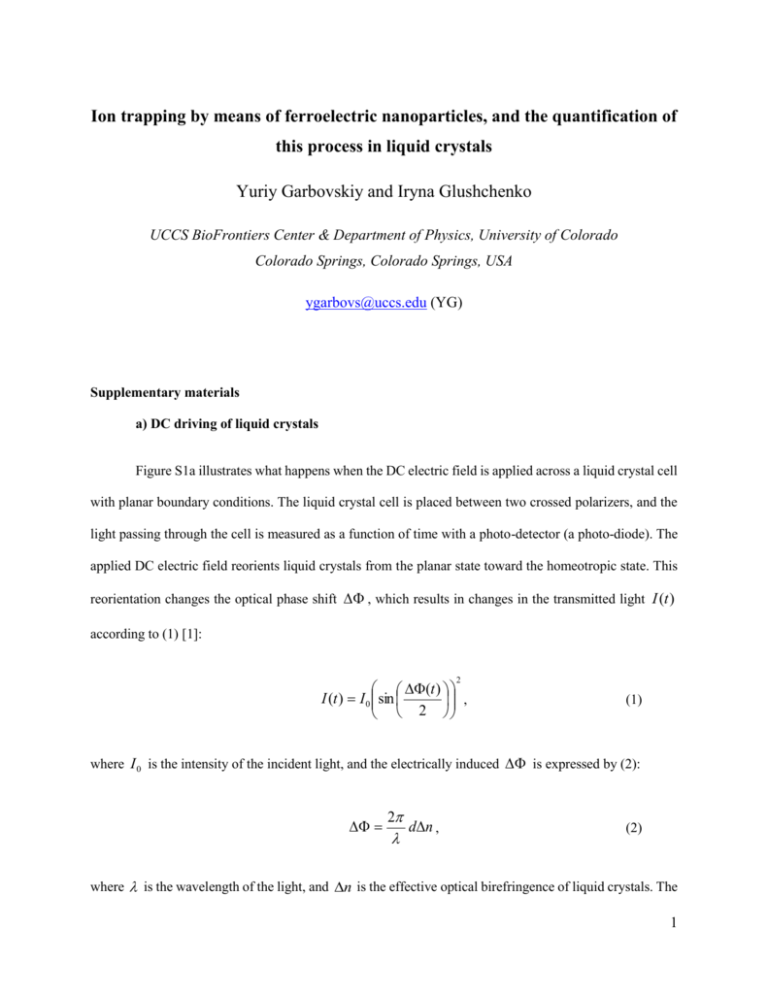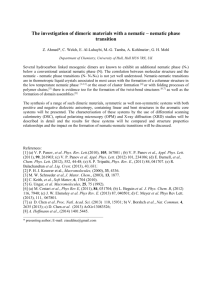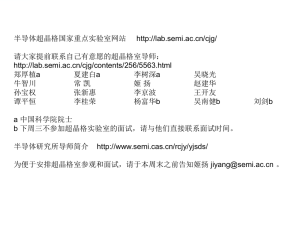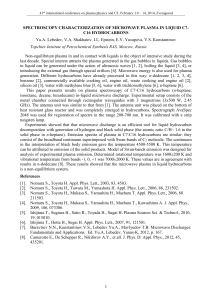057529APL_Sup
advertisement

Ion trapping by means of ferroelectric nanoparticles, and the quantification of this process in liquid crystals Yuriy Garbovskiy and Iryna Glushchenko UCCS BioFrontiers Center & Department of Physics, University of Colorado Colorado Springs, Colorado Springs, USA ygarbovs@uccs.edu (YG) Supplementary materials a) DC driving of liquid crystals Figure S1a illustrates what happens when the DC electric field is applied across a liquid crystal cell with planar boundary conditions. The liquid crystal cell is placed between two crossed polarizers, and the light passing through the cell is measured as a function of time with a photo-detector (a photo-diode). The applied DC electric field reorients liquid crystals from the planar state toward the homeotropic state. This reorientation changes the optical phase shift , which results in changes in the transmitted light I (t ) according to (1) [1]: 2 (t ) I (t ) I 0 sin , 2 (1) where I 0 is the intensity of the incident light, and the electrically induced is expressed by (2): 2 dn , (2) where is the wavelength of the light, and n is the effective optical birefringence of liquid crystals. The 1 applied electric field changes n and this change can be measured and analysed quantitatively using equations (1)-(2). Figure 1 (a) The electro-optical response of a liquid crystal cell filled with nematic E7 (planar boundary conditions). (b) Schematic representation of the liquid crystal reorientation under the action of a DC electric field. (c) Applied electric field is screened by a field caused by the presence of ions in the liquid crystal. Peak 1 shown in Figure 1a corresponds to the reorientation of the liquid crystal from a planar orientation toward the homeotropic (as shown schematically in Figure 1b). In this particular case, when 2 V are applied across a 10 mkm thick cell filled with liquid crystal E7, the reorientation takes less than a quarter of a second . At the same time, the ions present in the liquid crystal move toward the substrates under the action of the DC electric field. These ions generate a so-called screening field, which is opposite to the external field. As a result, the combined electric field decreases over time, and the liquid crystal reorients back toward the initial planar state. This process is reflected by Peak 2, shown in Figure 1a, and is schematically explained in Figure 1c. In the considered example, the screening electric field compensates the applied electric field in less than 3 seconds, resulting in the substantial alteration of the liquid crystal performance. Had the concentration of ions in the liquid crystals been negligibly small, this effect would never happen. b) The literature review Table 1. Effect of nanoparticles on the electrical conductivity of liquid crystals. 2 Nanoparticles Liquid crystals Results Ref. FLC NLC NLC FLC NLC Decrease in ion concentration Ion trapping Increase in the conductivity Reduced AC conductivity Decrease in ion concentration [2] [3-5] [6] [7-8] [9-10] NLC PDLC CLC FLC NLC FLC NLC Increase in the conductivity Increase in the conductivity Increase in the conductivity Increase in the conductivity Ion trapping Decrease in the conductivity/dielectric losses Both decrease and increase in the conductivity [11-13] [14] [15] [16-18] [19-20] [21-24] [25-27] FLC NLC CLC ColLC NLC NLC NLC ColLC NLC FLC Reduced AC conductivity Two orders increase in the conductivity Capture and release of ions Five-six orders increase in the conductivity Enhancement of the electrical conductivity Increased dielectric losses Increased anisotropy of the conductivity Enhancement of the electrical conductivity Ion trapping Increase in the conductivity [28-29] [30-32] [33] [34-38] [39] [40] [41] [42] [43] [44] NLC Reduced ion current and improved voltage holding ratio, decrease in ion concentration [45-55] FLC Decrease in the conductivity [56-59] ColLC Increase in the conductivity [60] NLC Voltage-assisted ion reduction [61] Decrease in the concentration of ions Decrease in the conductivity Release of the trapped ions under the action of the electric field [62-63] [64] Carbon-based nanomaterials Fullerenes Graphene Carbon nanotubes Diamond nanoparticles Metal nanoparticles Gold Gold and Aerosil Palladium Silver Copper Nickel Oxides ZnO , TiO2 , Al2O3 , ZrO2 , Y2O3 , Co3O4 TiO2 , Al2O3 , ZrO2 , MgO ZnO SiO2 Semiconductor quantum dots and nanorods FLC CdSe FLC CdS CdSe / ZnS NLC [65] Ferroelectric nanoparticles LiNbO3 FLC Ion trapping [66] Sn2 P2 S 6 NLC Increase in the conductivity [67] BaTiO 3 NLC Decrease in the concentration of ions [68] Other materials Nanoclay (montmorillonite) NLC Conducting nanofiber Polymeric nanoparticles NLC FLC FLC ZnO1 x S x Ion trapping, time dependent properties, and aggregation Increase I n the conductivity Decrease in dielectric losses Increase in the conductivity [69-75] [76-77] [78] [79-80] 3 FLC – ferroelectric liquid crystals NLC – nematic liquid crystals CLC – cholesteric liquid crystals ColLC – columnar liquid crystals PDLC – polymer dispersed liquid crystals c) The model of a reversible second order reaction applied to ferroelectric nanoparticles We will estimate n NP ,eff by applying the simplest model of a reversible second order reaction to our system (this oversimplification is meant only to highlight the importance of the aggregation factor in the quantitative way) [81]. In this model, we will consider only two-particle collisions. These collisions, described by the rate constant k A , lead to the formation of the aggregate made of two particles. The concentration of the formed aggregates is n A . The aggregate can dissociate and form two particles. This process is described by the rate constant k D and can be facilitated by applying external perturbing factors, such as continuous mechanical shaking and/or sonication, to the system. The following rate equation (3) and the particle conservation equation (4) describe the above-mentioned processes: dnNP ,eff dt k A nNP ,eff 2k D n A , 2 nNP nNP ,eff 2n A , Assuming that equilibrium is reached ( dnNP ,eff dt (3) (4) 0 ), we can find the following equation (5) for the nNP ,eff : nNP ,eff k D kA nNP , (5) 4 References [1] V G Chigrinov, Liquid crystal devices: physics and applications, Artech House, Boston 360 p ., 1999. [2] R. K. Shukla, K. K. Raina, and W. Haase, Liq. Cryst. 41(12), 1726 417 (2014). [3] W. Lee, C.-Yu. Wang, and Yu.-C. Shih, Appl. Phys. Lett. 85, 513 (2004). [4] C. Y. Huang and H. C. Pan, Appl. Phys. Lett. 89, 056101 (2006). [5] S. Y. Jeon, S. H. Lee, and Y. H. Lee, Appl. Phys. Lett. 89, 056102 (2006). [6] V. E. Vovk, A. V. Koval’chuk, and N. Lebovka, Liq. Cryst. 39(1), 77 (2012). [7] D. P. Singh, S. K. Gupta, T. Vimal, and R. Manohar, Phys. Rev. E 90, 022501 (2014). [8] R. Basu, Appl. Phys. Lett. 105, 112905 (2014). [9] Po.-C. Wu and W. Lee, Appl. Phys. Lett. 102, 162904 (2013). [10] R. Basu, A. Garvey, and D. Kinnamon, J. Appl. Phys. 117, 074301 (2015). [11] O. Yaroshchuk, S. Tomylko, O. Kovalchuk, and N. Lebovka, Carbon 68, 389 (2014). [12] T. Vimal, S. Pandey, S. K. Gupta, D. P. Singh, and R. Manohar, J. Mol. Liq. 204, 21 (2015). [13] L. N. Lisetski, S. S. Minenko, V. V. Ponevchinsky, M. S. Soskin, A. I. Goncharuk, and N. I. Lebovka, Materialwiss. Werkstofftech. 42(1), 5 436 (2011). [14] G. De Filpo, S. Siprova, G. Chidichimo, A. I. Mashin, F. P. Nicoletta, and D. Cupelli, Liq. Cryst. 39, 359 (2012). [15] O. K€oysal, Synth. Met. 160(9–10), 1097 (2010). [16] R. K. Shukla, K. K. Raina, V. Hamplova, M. Kaspar, and A. Bubnov, Phase Transitions 84(9–10), 850 (2011). [17] J. Prakash, A. Choudhary, D. S. Mehta, and A. M. Biradar, Phys. Rev. E 80, 012701 (2009). [18] Neeraj and K. K. Raina, Physica B 434, 1 (2014). [19] C.-W. Lee and W.-P. Shih, Mater. Lett. 64(3), 466 (2010). [20] Bo.-Ru. Jian, C.-Yu. Tang, and W. Lee, Carbon 49(3), 910 (2011). [21] A. Malik, J. Prakash, A. Kumar, A. Dhar, and A. M. Biradar, J. Appl. Phys. 112, 054309 (2012). [22] P. Arora, A. Mikulko, F. Podgornov, and W. Haase, Mol. Cryst. Liq. Cryst. 502(1), 1 (2009). [23] P. Ganguly, A. Kumar, S. Tripathi, D. Haranath, and A. M. Biradar, Liq. Cryst. 41(6), 793 (2014). [24] R. Basu, Appl. Phys. Lett. 103, 241906 (2013). 5 [25] P.-S. Chen, C.-C. Huang, Y.-W. Liu, and C.-Yu. Chao, Appl. Phys. Lett. 90, 211111 (2007). [26] S. Tomylko, O. Yaroshchuk, O. Kovalchuk, U. Maschke, and R. Yamaguchi, Ukr. J. Phys. 57(2), 239 (2012). [27] S. Tomylko, O. Yaroshchuk, O. Kovalchuk, U. Maschke, and R. Yamaguchi, Mol. Cryst. Liq. Cryst. 541(1), 35 (2011). [28] R. K. Shukla, X. Feng, S. Umadevi, T. Hegmann, and W. Haase, Chem. Phys. Lett. 599, 80 (2014). [29] F. V. Podgornov, A. V. Ryzhkova, and W. Haase, Appl. Phys. Lett. 97, 212903 (2010). [30] S. Sridevi, S. K. Prasad, G. G. Nair, V. D’Britto, and B. L. V. Prasad, Appl. Phys. Lett. 97, 151913 (2010). [31] S. K. Prasad, M. V. Kumar, T. Shilpa, and C. V. Yelamaggad, RSC Adv. 4, 4453 (2014). [32] S. K. Prasad, K. L. Sandhya, G. G. Nair, U. S. Hiremath, C. V. Yelamaggad, and S. Sampath, Liq. Cryst. 33(10), 1121 (2006). [33] M. Infusino, A. De Luca, F. Ciuchi, A. Ionescu, N. Scaramuzza, and G. Strangi, J. Mater. Sci. 49(4), 1805 (2014). [34] M. Mishra, S. Kumar, and R. Dhar, RSC Adv. 4, 62404 (2014). [35] Supreet, R. Pratibha, S. Kumar, and K. K. Raina, Liq. Cryst. 41(7), 933 (2014). [36] L. A. Holt, R. J. Bushby, S. D. Evans, A. Burgess, and G. Seeley, J. Appl. Phys. 103, 063712 (2008). [37] B. S. Avinash, V. Lakshminarayanan, S. Kumar, and J. K. Vij, Chem. Commun. 49, 978 (2013). [38] S. Kumar, Liq. Cryst. 41(3), 353 (2014). [39] B. Kamaliya, M. V. Kumar, C. V. Yelamaggad, and S. K. Prasad, Appl. Phys. Lett. 106, 083110 (2015). [40] 1S. Kobayashi, Y. Sakai, T. Miyama, N. Nishida, and N. Toshima, J. Nanomater. 2012, 460658. [41] U. B. Singh, R. Dhar, R. Dabrowski, and M. B. Pandey, Liq. Cryst. 40(6), 774 (2013). [42] P. Yaduvanshi, S. Kumar, and R. Dhar, Effects of copper nanoparticles on the thermodynamic, electrical and optical properties of a disc-shaped liquid crystalline material showing columnar phase, Phase Transitions: A Multinational Journal, DOI: 10.1080/01411594.2014.984710 [43] H. M. Lee, H.-K. Chung, H.-G. Park, H.-C. Jeong, J.-J. Han, M.-J. Cho, J.-W. Lee, and D.-S. Seo, Liq. Cryst. 41(2), 247 (2014). [44] Neeraj and K. K. Raina, Opt. Mater. 35(3), 531 (2013). [45] W.-T. Chen, P.-S. Chen, and C.-Y. Chao, Jpn. J. Appl. Phys., Part 1 48, 015006 (2009). [46] W.-T. Chen, P.-S. Chen, and C.-Yu. Chao, Mol. Cryst. Liq. Cryst. 507(1), 253 (2009). 6 [47] P.-S. Chen, C.-C. Huang, Y.-W. Liu, and C.-Yu. Chao, Mol. Cryst. Liq. Cryst. 507(1), 202 (2009). [48] T.-R. Chou, J. Hsieh, W.-T. Chen, and C.-Yu. Chao, Jpn. J. Appl. Phys., Part 1 53(7), 071701 (2014). [49] B.-Jy. Liang, D.-G. Liu, W.-Yi. Shie, and Sy.-R. Huang, Jpn. J. Appl. Phys., Part 1 49, 025004 (2010). [50] C.-Yu. Tang, S.-M. Huang, and W. Lee, J. Phys. D: Appl. Phys. 44(35), 355102 (2011). [51] Y.-S. Ha, H.-J. Kim, H.-G. Park, and D.-S. Seo, Opt. Express 20(6), 6448 (2012). [52] H.-J. Kim, Y.-Gu. Kang, H.-G. Park, K.-M. Lee, S. Yang, H.-Y. Jung, and D.-S. Seo, Liq. Cryst. 38(7), 871 (2011). [53] H.-Y. Jung, H.-J. Kim, S. Yang, Y.-Gu. Kang, B.-Y. Oh, H.-G. Park, and D.-S. Seo, Liq. Cryst. 39(7), 789 (2012). [54] H.-K. Chung, H.-G. Park, Y.-S. Ha, J.-M. Han, J.-W. Lee, and D.-S. Seo, Liq. Cryst. 40(5), 632 (2013). [55] N. Yadav, R. Dabrowski, and R. Dhar, Liq. Cryst. 41(12), 1803 (2014). [56] T. Joshi, J. Prakash, A. Kumar, J. Gangwar, A. K Srivastava, S. Singh, and A. M. Biradar, J. Phys. D: Appl. Phys. 44, 315404 (2011). [57] A. Chandran, J. Prakash, P. Ganguly, and A. M. Biradar, RSC Adv. 3, 17166 (2013). [58] S. K. Gupta, D. P. Singh, and R. Manohar, Adv. Mater. Lett. 6(1), 68 (2015). [59] A. Chandran, J. Prakash, K. K. Naik, A. K. Srivastava, R. Da˛browski, M. Czerwinski, and A. M. Biradar, J. Mater. Chem. C 2, 1844 (2014). [60] Supreet, S. Kumar, K. K. Raina, and R. Pratibha, Liq. Cryst. 40(2), 228 (2013). [61] S.-W. Liao, C.-T. Hsieh, C.-C. Kuo, and C.-Y. Huang, Appl. Phys. Lett. 101, 161906 (2012). [62] R. K. Shukla, Y. G. Galyametdinov, R. R. Shamilov, and W. Haase, Liq. Crys. 41(12), 1889 (2014). [63] D. P. Singh, S. K. Gupta, P. Tripathi, M. C. Varia, S. Kumar, and R. Manohar, Liq. Cryst. 41(9), 1356 (2014). [64] P. Malik, A. Chaudhary, R. Mehra, and K. K. Raina, Adv. Condens. Matter Phys. 2012, 853160. [65] E. A. Konshina, I. F. Galin, and E. O. Gavrish, Univers. J. Mater. Sci. 2(1), 1 (2014). [66] R. K. Shukla, C. M. Liebig, D. R. Evans, and W. Haase, RSC Adv. 4, 18529 (2014). [67] E. Ouskova, O. Buchnev, V. Reshetnyak, Yu. Reznikov, and H. Kresse, Liq. Cryst. 30(10), 1235 (2003). [68] R. Basu and A. Garvey, Appl. Phys. Lett. 105, 151905 (2014). [69] Y.-M. Chang, T.-Y. Tsai, Y.-P. Huang, W.-S. Chen, and W. Lee, Jpn. J. Appl. Phys., Part 1 46(11), 7368 (2007). 7 [70] T.-Y. Tsai, Y.-P. Huang, H.-Yu. Chen, W. Lee, Y.-M. Chang, and W.-K. Chin, Nanotechnology 16(8), 1053 (2005). [71] H.-H. Liu and W. Lee, Appl. Phys. Lett. 97, 023510 (2010). [72] H.-H. Liu and W. Lee, Appl. Phys. Lett. 97, 173501 (2010). [73] Y.-P. Huang, H.-Yu. Chen, W. Lee, T.-Y. Tsai, and W.-K. Chin, Nanotechnology 16(4), 590 (2005). [74] N. Lebovka, A. Goncharuk, T. Bezrodna, I. Chashechnikova, and V. Nesprava, Liq. Cryst. 39(5), 531 (2012). [75] Y. Shaydyuk, G. Puchkovska, A. Goncharuk, and N. Lebovka, Liq. Cryst. 38(2), 155 (2011). [76] R. Manda, V. Dasari, P. Sathyanarayana, M. V. Rasna, P. Paik, and S. Dhara, Appl. Phys. Lett. 103, 141910 (2013). [77] M. V. Rasna, K. P. Zuhail, R. Manda, P. Paik, W. Haase, and S. Dhara, Phys. Rev. E 89, 052503 (2014). [78] A. Kumar, P. Silotia, and A. M. Biradar, J. Appl. Phys. 108, 024107 (2010). [79] D. P. Singh, S. K. Gupta, A. C. Pandey, and R. Manohar, Adv. Mater. Lett. 4(7), 556 (2013). [80] D. P. Singh, S. K. Gupta, and R. Manohar, Adv. Condens. Matter Phys. 2013, 250301. [81] N I Lebovka, Adv. Polym Sci, 255, 57-96 (2014). 8




